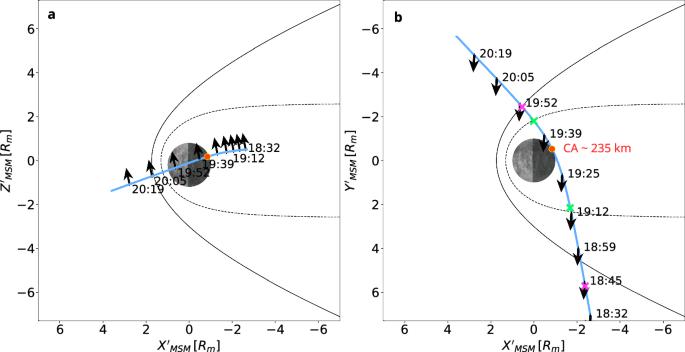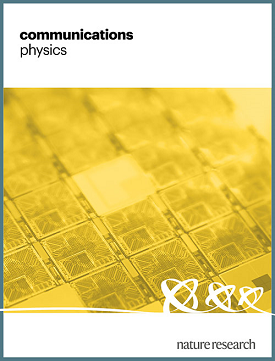Mercury’s plasma environment after BepiColombo’s third flyby
IF 5.4
1区 物理与天体物理
Q1 PHYSICS, MULTIDISCIPLINARY
引用次数: 0
Abstract
Understanding Mercury’s magnetosphere is crucial for advancing our comprehension of how the solar wind interacts with the planetary magnetospheres. Despite previous missions, several gaps remain in our knowledge of Mercury’s plasma environment. Here, we present findings from BepiColombo’s third flyby, offering a synoptic view of the large scale structure and composition of Mercury’s magnetosphere. The Mass Spectrum Analyzer (MSA), Mass Ion Analyzer (MIA), and Mass Electron Analyzer (MEA) on the magnetospheric orbiter reveal insights, including the identification of trapped energetic hydrogen (H+) with energies around 20 keV e−1 evidencing a ring current, and a cold ion plasma with energies below 50 eV e−1. Additionally, we observe a Low-Latitude Boundary Layer (LLBL), which is a region of turbulent plasma at the edge of the magnetosphere, characterized by bursty ion enhancements, indicating an ongoing injection process in the duskside magnetosphere flank. These observations during cruise phase provide a tantalizing glimpse of future discoveries expected from the Mercury Plasma Particle Experiment (MPPE) instruments after orbit insertion, promising broader impacts on our understanding of planetary magnetospheres. Due to its proximity to the Sun, the space plasma environment of Mercury is tightly coupled with the interior and the surface of the planet, and their interaction facilitate the escape of planetary material and energy exchange. The authors present data from the third flyby of the BepiColombo spacecraft revealing new evidence of trapped energetic hydrogen (H+) with energies of around 20 keV/e and highlight the presence of cold ion population below 50 eV/e in Mercury’s magnetosphere.

贝皮科伦坡号第三次飞越后的水星等离子体环境
了解水星的磁层对于推动我们理解太阳风如何与行星磁层相互作用至关重要。尽管以前执行过任务,但我们对水星等离子体环境的了解仍存在一些空白。在这里,我们将介绍贝皮科伦坡号第三次飞越水星的发现,提供水星磁层大尺度结构和组成的综合视图。磁层轨道飞行器上的质谱分析仪(MSA)、质子分析仪(MIA)和质子电子分析仪(MEA)揭示了一些见解,包括识别出能量在20 keV e-1左右的被困高能氢(H+),证明存在环流,以及能量低于50 eV e-1的冷离子等离子体。此外,我们还观测到低纬度边界层(LLBL),这是磁层边缘的一个湍流等离子体区域,其特征是迸发式离子增强,表明黄昏磁层侧翼正在进行注入过程。巡航阶段的这些观测结果为水星等离子体粒子实验(MPPE)仪器在进入轨道后的未来发现提供了诱人的一瞥,有望对我们了解行星磁层产生更广泛的影响。由于靠近太阳,水星的空间等离子体环境与行星的内部和表面紧密相连,它们之间的相互作用促进了行星物质的逃逸和能量交换。作者介绍了 BepiColombo 航天器第三次飞越水星的数据,这些数据揭示了能量约为 20 keV/e 的被困高能氢(H+)的新证据,并强调了水星磁层中存在低于 50 eV/e 的冷离子群。
本文章由计算机程序翻译,如有差异,请以英文原文为准。
求助全文
约1分钟内获得全文
求助全文
来源期刊

Communications Physics
Physics and Astronomy-General Physics and Astronomy
CiteScore
8.40
自引率
3.60%
发文量
276
审稿时长
13 weeks
期刊介绍:
Communications Physics is an open access journal from Nature Research publishing high-quality research, reviews and commentary in all areas of the physical sciences. Research papers published by the journal represent significant advances bringing new insight to a specialized area of research in physics. We also aim to provide a community forum for issues of importance to all physicists, regardless of sub-discipline.
The scope of the journal covers all areas of experimental, applied, fundamental, and interdisciplinary physical sciences. Primary research published in Communications Physics includes novel experimental results, new techniques or computational methods that may influence the work of others in the sub-discipline. We also consider submissions from adjacent research fields where the central advance of the study is of interest to physicists, for example material sciences, physical chemistry and technologies.
 求助内容:
求助内容: 应助结果提醒方式:
应助结果提醒方式:


